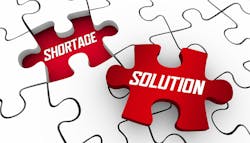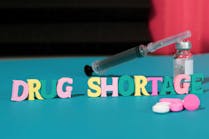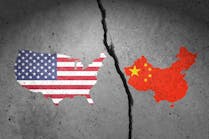Useful strategies, tactics that may redefine post-pandemic distribution
Amid the hustle and bustle of searching for ways to prevent the panicked purchasing that pricked the pandemic-plagued 2020-2021, a half-dozen options are emerging from the swirling fog of debate and discussion. Which may be adopted and implemented? Healthcare supply chain experts share with Healthcare Purchasing News their predictions, along with the positives and negatives, about some of the buzzworthy concepts.
Working with domestic and/or local suppliers to eliminate overseas shipping
“I don’t think the global supply chain is going away. The answer is in diversifying sourcing to include domestic and nearshore suppliers. The catchphrase these days is ‘supply chain resiliency.’ The challenge, of course, is moving from a traditional sole-source and committed-volume approach to contracting to a more opportunistic and dynamic approach. Manufacturers, distributors, GPOs and providers all need to play a part in designing a sourcing and contracting system that is more diverse, dynamic and more performance-based. Moving from a sole or dual source to a multi-source approach does add complexity, but it is a successful strategy employed widely by many other industries. Healthcare does present some unique challenges as you move along the continuum from commodity products to procedural and PPI products. More work needs to be done to establish functional equivalency data for comparing products and services.”
Mike Henry, Managing Partner, Ron Denton & Associates LLC
“Working with domestic and/or local suppliers to eliminate overseas shipping is a good strategy in certain ways. It could help alleviate the traffic jams we have seen as cargo ships line up at the ports of Los Angeles and Long Beach waiting to be unloaded. Domestic production would also eliminate other challenges faced when procuring goods from overseas, such delays with customs inspections. From a safety perspective, suppliers manufacturing products in the U.S. must comply with stringent guidelines and restrictions that may not exist overseas, especially in healthcare.
“The only negative aspect of domestic production that comes to mind is the added cost to manufacture products in the U.S. compared with other countries.”
Cory Turner, CMRP, Senior Director, Healthcare Strategy, Tecsys Inc.
“We are certainly supportive of increased manufacturing in the U.S.A. However, it isn’t feasible to move all manufacturing to the U.S.A. Additionally, you can’t just move the manufacturing; you would need to source the raw materials and manufacturing equipment locally as well. Otherwise, you haven’t really alleviated the risk. If we expand the focus to include all of North America, the feasibility of moving some manufacturing increases and the added costs might be reduced. We all want the security of having access to locally manufactured items but there is an added cost to that. The increase in transportation costs isn’t isolated to overseas shipping.”
Margaret Steele, Senior Vice President, Med/Surg, Vizient Inc.
“We’re seeing supply chain teams add suppliers to their networks but aren’t necessarily seeing companies reduce their overall number of suppliers. Diversifying suppliers comes with its own set of complexities. The challenge comes in managing yet another vendor for ordering and fulfillment — and making sure there are strategies in place to ensure you’re able to manage a more complex supply chain with visibility and agility.”
Alex Wakefield, CEO, Longbow Advantage
“Domestic/local suppliers can benefit an organization for ease of access and reduced lead time for shipping but could result in higher costs, if not managed appropriately. Depending on the type of supplies and implants, there may be limited options domestically, and introducing a domestic/local supplier may create more fragmentation within a product category. Having a domestic/local supplier as a secondary or backstop source will allow for the organization to better absorb fluctuations in demand, especially where certain products are on allocation.”
Tom Redding, Senior Managing Director, Healthcare Services, St. Onge Co.
“Before the pandemic, a large majority of supplies were sourced overseas, and we saw the unfortunate impacts of international distribution channels. Buying American-made seems like the no-brainer solution, and it does have its sourcing benefits; although, our industry might have to sacrifice profit margins to support domestic manufacturing in the United States rather than overseas. Right or wrong, the healthcare supply chain is now global. In the short term, healthcare providers must double down on risk assessments during the source to contract process. Longer term, products must be classified by criticality, and onshore manufacturing must be considered as manufacturers are incented to build domestically (which will happen) and their domestic capacities come online.”
Michael DeLuca, Executive Vice President, Operations, Prodigo Solutions Inc.
“Diversifying your supply base is a critical component to having a reliable supply chain. Organizations benefit from leveraging relationships both domestic and overseas which allows for flexibly when demand fluctuates, and supply doesn’t respond as the same pace. This is why a strategy that overly relies on one over the other can be very risky. In addition, streamlining supply purchasing to one or two manufacturers or moving production ‘in-house,’ while short term, can create a sense of security but does not create a flexible, resilient and adaptable model that can quickly address issues that may arise with raw materials or an operating location, etc.
“One way to create an adaptable model is building e-commerce into your supply chain strategy, allowing organizations to easily access millions of supplies across a range of domestics and international suppliers, without the burden of managing one by one the addition of these new vendors. Leveraging technologies that prioritize speed to supply access outweigh traditional models of one-off vendor negotiations and outdated contracting models. These new e-commerce models reduce dependence on one strategy vs another and allow organizations to protect themselves from supply disruptions of all kinds including natural disasters and pandemics.”
Sandhya Dhir, Head of Healthcare Strategy and Development, Amazon Business
“Sometimes this makes sense, but not always. Plus, the end customers must be willing to pay more. Because we don't see hospitals absorbing the costs, as it is unlikely reimbursement goes up, when the supply chain issues resolve, purchasers will once again move to the most cost-effective items. We need to look at the supply chain holistically, but this isn’t the easy answer we all wish it could be.”
James Sembrot, Senior Vice President, U.S. Supply Chain, Cardinal Health
“There is value in this approach because supporting local has many benefits to a community and it helps manage risk from supply shortages, etc. The challenge is measuring the value of this approach especially when CFOs start banging the drum again to lower acquisition costs and invoice costs for products. This is not a solution for everything but can and should be a solution for some things. It helps build and support strong local/regional economies.”
Steve Kiewiet, FAHRMM, FACHE, COO, CCS Medical, and Immediate Past Chair, AHRMM
“Yes, we have seen an increased interest in domestic manufacturing. In fact, during the pandemic, Medline stepped up domestic manufacturing efforts for products essential in the fight against the pandemic, including hand sanitizer and face masks. However, to ensure the long-term resiliency of the supply chain, it is still important that the industry manufacture with more variety and not rely on one continent to manufacture healthcare products. In addition to Asia and North America, the industry should continue to take a look at efforts to disperse manufacturing across Europe and South America as well.”
Peter Saviola, Vice President, Logistics and Supply Chain Optimization, Medline Industries
“During the height of COVID, many MedSpeed customers adjusted their supplier mix to include more domestic suppliers and formed partnerships with manufacturers of other goods to rapidly-produce PPE. Today, as we face new challenges, having this experience will help the supply chain remain agile. I expect many of the practices we learned during COVID will increase our long-term agility and make the supply chain stronger.”
Jake Crampton, Founder and CEO, MedSpeed
“Today many healthcare products are sourced from overseas suppliers and there is a lack of manufacturing capacity in the United States. This has come to the forefront during the pandemic, particularly in the early days, when personal protective equipment (PPE) was in high demand and short supply. However, eliminating overseas shipping is not a one-size-fits-all solution to supply chain challenges. A sourcing strategy needs to consider raw materials, labor, costs, technology, skills, quality, lead-time, environmental and social impacts and risk. Diversifying sourcing across suppliers and regions is an effective way to balance these factors.”
Jim Mullins, Senior Vice President, Global Supply Chain, Henry Schein Inc.
“This must be part of the strategy. Geographically diverse and U.S.-based manufacturing will help reduce overreliance on any single country or region for healthcare supplies and medications. Premier’s philosophy is not to pick up all overseas manufacturing onshore or nearshore, but to have an appropriate amount of backstop. Our belief is that a successful strategy must be domestic – and it must be diverse.
“For critical supplies, including raw materials, there should be three or more global suppliers and at least one U.S.-based source readily available to serve the American people. This diverse and balanced approach is not just a better contingency plan for emergencies, but it also recognizes the need for global sourcing to keep costs in check and help alleviate U.S. national security concerns.”
James Ludwig, Vice President, Partnerships, Premier Inc.
“At McKesson Medical-Surgical, we are actively collaborating with our global network of suppliers and continue to diversify our product and supplier portfolios to ensure we are efficiently getting product from U.S. ports to our distribution centers.
“McKesson Medical-Surgical is fortunate to have an extensive global and domestic transportations and logistics team to help expedite product brokerage, customs clearance, ocean partner negotiations and freight vessel booking to efficiently get product from U.S. ports to our distribution centers. We are also expanding transload operations and using trucking and Canadian rail for certain destinations.
“In collaboration with our network of suppliers, we are able to actively monitor the country of origin of our products, raw materials, lead times and availability to determine whether or not we need to make adjustments to our supplier base in specific product categories.”
Jack Slagle, Vice President, Category Management, McKesson Medical-Surgical
Stockpiling product (well beyond safety stock caches) either onsite (at an offsite warehouse, etc.) or via supplier facility or via government agency
“Having a strategic stockpile solution is tremendously valuable when it comes to responding quickly for public health emergencies and/or pandemic responses readiness. From monitoring and maintain inventory levels, transmission of shipping records, ensuring stock rotating, tracking PPE and other critical product categories and repaid delivery to all facilities, stockpile program requirements can be very complex. McKesson’s stockpile program and model is built to support you with the resources and delivery expertise you need for point of care readiness and accountability.”
Jennifer Conner, Senior Director, Project Management, Customer Experience & Operations, McKesson Medical-Surgical
DHIR: “With fresh wounds from the pandemic and natural disasters (e.g., Hurricane Ida), stockpiling can feel like one of the few options for organizations to protect themselves. However, managing inventory onsite where space is limited, or off-site, essentially turning into a 3PL, can be a challenging addition to operations, consuming value time and cash flow. One way to create a better balance is leveraging cloud and AI-enabled e-commerce technology to create a robust backorder and scare supply protocol, allowing organizations access to critical supplies from a multitude of sources, and reduce reliance on stockpiles. At Amazon Business, our vast selection and world class fulfillment network allow organizations to access a wide range of supplies at any given time. During Hurricane Ida, organizations impacted quickly relied on Amazon to access critical supplies such as tarps, flashlights, and critical personal items likes toothpaste which Amazon was able to pull from our vast fulfillment network and deliver into Louisiana within days. This was during a time when other carriers were unable to access the region for weeks. Having a reliable solution to accessing critical supplies that allow for just-in-time deliveries to facilities reduces staff hours and working capital at the same time maximizing existing space.”
KIEWIET: “This is a knee-jerk reaction to a global supply chain meltdown. In the long run, this becomes very problematic to manage – especially when items have expirations. This also creates even larger bullwhip situations because stockpiling doesn’t fix any of the fundamental issues that created the problem in the first place. It is the equivalent of treating pain with more and more pain meds instead of fixing the source of the pain. For anyone that needs a refresher on this, go find your local college/university and join the supply chain majors in the beer game.”
STEELE: “Having 90-180 days [of] owned inventory is a terrific safety net. However, the logistics around warehousing and rotating this inventory can be costly. Some have suggested that dedicated production capacity and raw materials might be a better approach to safety stock. We would all like to see additional transparency around the national stockpile and the steps to access it.
“Additionally, stockpiles may have a limited impact for prolonged shortages or backorders. If we reflect on masks early in the pandemic, typical usage skyrocketed to 15 times the normal usage rates. Under this scenario, a six-month stockpile would have lasted for mere days.”
HENRY: “The challenge with stockpiling is that it typically prepares for the last crisis not the next crisis. There are supplies such as PPE that should always be held in reserve in some quantity, but it’s difficult to determine what the next major disruption will be. In addition, stockpiling distorts demand in the short term, which requires increased communication and data visibility across the supply chain. Providers should also consider suppliers’ (or distributors’) capabilities for virtual stockpiling with guaranteed delivery. Suppliers (or distributors) are in a much better position to manage and rotate the inventory and share data upstream to supplier manufacturers. Based on recent experience with out-of-date product in national stockpiles, there doesn’t appear to be a comprehensive and reliable safety net at the federal, state or local level. “
TURNER: “While there should always be safety or emergency stock available, there is a fine line between having a reasonable supply backup and stockpiling excessive inventory. Stockpiling goes right back to the issue of panic buying driven by human behavior. When health systems stockpile products, it drains the overall supply chain and puts unneeded pressure and problems on both internal resources and manufacturers. Instead, health systems should employ analytics to determine an appropriate level of supply reserves based on past consumption and anticipated future needs (e.g., forecasting, demand planning).”
WAKEFIELD: “We aren’t seeing ‘just in time’ necessarily going away as a strategy, but supply chain teams are definitely revisiting how they approach these types of strategies. For some, this has come in the form of stocking up. However, the reality is warehouses or [distribution centers] can only hold so much product. For supply chains that are looking to restructure their just-in-time strategies, they’ll need to be hyper-vigilant about efficiency when it comes to storage, throughput and things like cross-docking for more immediate shipments in order to maximize the space they have. Visibility into – and maximizing – warehouse capacity and order fulfillment across the network will be more important than ever before for companies that need to increase contingency-order storage.”
REDDING: “Having a multiple layer supply chain does create a potential opportunity for waste and efficiency but it will allow for the supply chains to absorb higher than expected demand. Sharing inventory within a smaller geographic area or region could benefit various health systems to handle unknowns for a certain subset of products, such as: PPE. There could be more complexity with allocating shared inventory across health systems. Many health systems are working closely with their distributor(s) to store additional products, and inventory levels in excess of their inventory allocation. It allows for more flexibility to store, access, distribute and deliver to various points throughout a network with minimal infrastructure requirements.
“However, creating multiple layers to the supply chain is typically counter to an efficient supply chain. As supply chains move from an efficiency model to a hybrid model, we will see more supply chains incorporate resiliency into the equation. This includes manufacturing and distribution capacity. Additionally, as more layers of the supply chains are considered, it will create an environment where being nimble is not an option, or severely limited. It will also create the need for better inventory visibility across the supply chain to better respond to customer’s needs. Having more inventory doesn’t always mean higher degrees of product availability. It could actually get worse if inventory visibility is readily available.”
DeLUCA: “Stockpiling has its positives and negatives. Stocking beyond short term needs helps to lessen the strain of sudden spikes in item demand and usage, and it can also reap the rewards of bulk purchasing. In contrast, this strategy comes with the disadvantage of capital being tied up in excess inventory and the risks of expiring items. Providers will need to assess each category of product differently and develop inventory plans by category.”
CRAMPTON: “Taking aside the question of how much is too much, an often-overlooked aspect of a stockpiling or safety caching is same-day logistics. A logistics infrastructure that fully connects all points of care with the stockpile can allow rapid deployment and repositioning of supplies, while avoiding the waste that can sometimes be associated with too many stock locations. The critical factor in creating a logistics infrastructure that can support this strategy deploys route optimization technology to consolidate the routing structure into a dependable network upon which the entire health system can rely.”
SEMBROT: “Customers will – and should – carry slightly higher inventories, working together with their distributor to identify the best solution on net costs and stock rotation, etc.”
SAVIOLA: “Stockpiling as a concept is common, and the pandemic taught us it can be difficult to manage. Owning a stockpile requires capital and space to store products and constant visibility into inventory so products that are expiring can be rotated out. We are seeing the need to develop smarter stockpiles and a process for replenishing and managing stock on behalf of our customers. “One example in response to supply chain complications during the pandemic [is] Medline’s supply chain optimization (SCO) and logistics teams worked closely with individual healthcare facilities to create a new way to manage, store and deliver customer-owned inventory. Medline’s investments in over 23 million square feet of medical-grade distribution space have allowed for the handling of more than 450,000 square feet of customer-owned inventory. In the case of one healthcare system, the Medline 3PL solution helped it navigate physical space and distribution challenges brought on by COVID-19. Medline provided warehouse space to alleviate the issue. This freed up system teams to coordinate bulk buys on behalf of its entire system and deliver them to a single location. As individual facilities needed product, they could draw from that centralized inventory utilizing Medline’s distribution and delivery infrastructure. “In addition, Medline also recently created a new program where, through a subscription-based model, Medline owns, stores and rotates, critical PPE products in our facilities and replenish for customers as needed – giving them the security of a stockpile without the responsibility of managing or owning the inventory.”
MULLINS: “Best practices for reducing risk include improved forecasting and planning, enabling supply chain visibility and optimizing product offerings. At Henry Schein, we strongly support the Office of the Assistant Secretary for Preparedness and Response’s (ASPR) strategy to expand and enhance the Strategic National Stockpile (SNS) and its capabilities to supplement state and local medical supplies in response to the COVID-19 pandemic and for future public health emergencies. In May 2021, we were awarded a $53.4 million contract from the U.S. Department of Health and Human Services (HHS) for the storage and distribution of 80,000 pallets of PPE and COVID-19 related products to support the SNS. This agreement will further the efforts of ASPR to leverage the collective strengths of both the public and private sectors. In addition, it will help maximize the breadth of coverage and capabilities, minimize vulnerabilities, and facilitate an expedited response to public health crises and other emergencies.”
LUDWIG: “States and health systems need to feel confident in their ability to access an emergency stock of supplies, but we must reinforce providers’ efforts with a national strategy that ensures coordination and reliability across stockpiles.
“Premier advocates for the creation of a national standard that integrates stockpiling needs at the federal, state and health system levels. Premier recommends a hub-and-spoke model that leverages the Strategic National Stockpile (SNS) as well as a network of state and health system stockpiles, with an emphasis on collaboration and coordination between the entities maintaining inventories of supplies. Premier’s recommendations can enhance transparency within the SNS and create a national standard for all stockpiles, including those at the state or local level, to ensure consistency and interoperability.”
Setting up a Consolidated Service Center to function in part as a third-party logistics (3PL) service or some kind of hybrid 3PL
STEELE: “This solution offers a unique approach for providers to isolate and secure their own inventory to avoid it getting inadvertently shared with another facility. However, the approach doesn’t come without risk. First, a facility needs to have scale to support the need for dedicated space. Second, the cost associated with purchasing product upfront and then paying a third party to manage the inventory requires significant free capital. Lastly, one of the significant benefits of leveraging a traditional distributor is to access available product they have locally and in stock. This model puts more pressure on the provider to ensure accurate demand planning. Some providers are looking to overcome these barriers by exploring shared collaboratives or affiliations.”
HENRY: “Consolidated Service Centers mean different things to different people. The key question to ask when contemplating a CSC:
- What is the primary goal of having our own CSC?
- What are the primary services that will be provided in the CSC?
- Is this our core competency?
- Is there a return on investment?
“For providers, setting aside and monitoring safety stock and pandemic inventory doesn’t require a CSC. It just takes moderate warehouse space and basic systems for monitoring and rotating inventory. Implementing a CSC at the provider level is costly and requires significant scale to be efficient. Providers should work with suppliers – or distributors or 3PLs – that have storage space and offer provider stockpile inventory to be owned by the provider so they can access it as needed, without allocation constraints. In addition, the supplier, distributor or 3PL should have 3PL capabilities for specific activity with the goal of maintaining and rotating critical supplies regionally or locally resulting in improved lead time and increased data visibility. This can be particularly useful for traditionally direct purchase items.”
TURNER: “CSCs are extremely scalable and are typically architected to operate at high efficiency. This combination makes it quite suitable to accommodate an evolving hospital ecosystem, whether those hospitals are part of a health system network, integrated via acquisition or through commercial agreements. There are fantastic examples of exactly this business model around the U.S., and I imagine most midsize-to-large health systems have, to some degree, explored this option. Some of our customers have successfully commercialized their CSC in that hybrid manner. One that comes to mind is a midsize regional health system of nine hospitals that collaborated with another much larger multistate health system by providing CSC services to those larger health system’s facilities. Certainly, this adds complexity to the overall [supply chain management] environment, but that complexity is hedged by profitability and the advantages of economies of scale.”
WAKEFIELD: “This all comes down to visibility. 3PLs are a massively integral part of the supply chain, and the most successful 3PL strategies rely on 360-degree communication and visibility into orders and overall efficiency. The power of a 3PL network is huge but being mindful about customer communication and efficiency is always going to be the key to a successful 3PL strategy.”
REDDING: “Setting up a CSC can have significant benefits for an organization to provide a higher level of service to its hospital customers, including supporting direct delivery to patients. Creating a hybrid model, which handles the typical B2B activities, while being flexible to support B2C activities will be critical for the future. Incorporating the use of a 3PL to manage the health system’s supply distribution operations is definitely gaining traction. As health systems become more decentralized in the delivery of care, the ability to service multiple types of customers with varying degrees of requirements and expectations can quickly grow past the abilities of the health system’s internal supply chain team.
“[However], consider a CSC must be taken seriously, and not ‘just renting warehouse space’ and assume all of the same distribution and logistics practices will apply. One of the biggest challenges with a CSC is having a robust courier/transportation network to service customers efficiently and effectively. Additionally, a health system will need to take a hard look at their supply chain systems and technology to make sure they are ready for broader support from a centralized location. Lastly, to manage and distribute supplies from a system level, the health system must review their organizational structure and knowledge to identify potential blind spots.”
DeLUCA: “Health systems are becoming more and more decentralized, and so are their distributions. Consolidated service centers can help to reduce waste and can provide a health system with better inventory insights and management.”
SEMBROT: “There could be benefit in a ‘national stockpile’ managed by each distributor for its customers. This would provide visibility to customers on how much stock they want housed. If they want 60, 90 or 120 days, the distributor could do that, and charge appropriately.”
KIEWIET: “CSCs have always been a key strategy to manage supply chain risk. It is a smart choice for some health systems and not for others. There are many tools and consultants that can help you down this path of analysis. My caution would be to make sure that you fully understand the problem(s) you are trying to solve and if this approach can help to solve them. If this is just another version of stockpiling, then it may not get you the result you desire for your supply chain. Everyone building their own distribution system and stockpile only masks the problems that exist in the supply chain, they don’t solve them.”
SAVIOLA: “We are seeing more healthcare systems express interest in setting up a consolidated service center. But setting up and managing these facilities are an expensive and time-consuming endeavor. Leveraging a consolidated service center beyond traditional medical surgical product delivery is the key. So services such as pandemic stockpile management, centralizing the purchase and stocking of expensive mission critical items and ancillary services that add value to the supply chain, such as kitting and case cart assembly, are just some of the opportunities to leverage the investment.”
MULLINS: “Our network consists of distribution centers strategically located in key regions. For our business, a consolidated service center would likely put our product farther away from customers and increase our transportation costs and lead times.”
Relying on government designs/efforts to manage the supply chain
SAVIOLA: “It is critical that health systems do not solely rely on government supplies. Government itself tells providers that they must have a plan A and plan B in place. A government-owned stockpile is meant to serve as the backup plan to the backup plan.”
MULLINS: “Evaluating the physical and technological infrastructure of ports, airports and rails – driven by public-private partners, including federal, state and local governments – would help ensure we can support the future growth of the supply chain. The government could also look to support policies that promote flexibility and agility in the current labor market.
“As co-founder of the Pandemic Supply Chain Network (PSCN), a public-private partnership aimed at saving lives by strengthening the resilience of the global health supply chain in response to pandemics, Henry Schein understands first-hand the value that these partnerships can bring to address complex societal issues. Through the PSCN, we have had the opportunity to work with leaders from all sectors of society to help create a safer world through more effective pandemic preparedness and response. The trust-based relationships built between sectors is crucial in enabling the sharing of information and facilitating the ability of key stakeholders to navigate together the supply chain challenges caused by global pandemics.”
STEELE: “Given the differences between city, state and federal approaches to supply chain and stockpiling efforts, we are more confident in the ability to manage the supply chain in the healthcare industry. Our preference is that we continue to work closely with many of the governmental agencies such as the FDA to ensure awareness and support as needed. The government can also help alleviate some of the bottlenecks we are experiencing by working with the port authorities, helping create awareness and priority for the critical medical products that are sitting on ships in the ports and possibly utilizing the national guard for transporting medical products from the ports to the warehouses. Additionally, we remain optimistic around future policies that improve funding and subsidies for domestic and/or nearshore production and storage.”
HENRY: “The role of government is and should be at the macro level supporting improvement in ports throughput and other logistics efficiencies. In the future there may be various public/private partnership initiatives that support supply chain resiliency, but those initiatives are ill defined at this point. The recent Supply Chain challenges at the ports have shown us that a stretched supply chain has a tremendous impact on costs and overall supply availability.”
TURNER: “The healthcare supply chain has specific nuances and challenges quite different from general distribution, retail and other sectors. While the government may have resources in place to manage supply chain at a high level, when we get down into the weeds of healthcare supply management, they likely don’t have the expertise to manage it effectively.”
REDDING: “Depending on the variability of demand, there could be a potential to leverage the government’s relationships with various businesses to assist in expediting the movement of supplies and equipment.
“[However], relying on the government can have its benefits, but serious thought should be spent to determine if a more regional/local solution is more appropriate. Having visibility at the national level can be a constraint, and mobilizing resources in a timely manner.”
DeLUCA: “During the peak of the pandemic, the Federal Emergency Management System asked hospitals to have at least a 90-day supply on hand for supplies such as masks, face shields, gloves and isolation gowns. Hospitals should view the federal guidance as a starting point. However, they should also recognize that this results in added costs that are especially difficult for smaller hospitals to absorb.”
SEMBROT: “This is a less viable solution. Government should allocate dollars for infrastructure.”
KIEWIET: “I am not aware of any government capable of managing supply chain effectively. Industry can and should solve their own problems so government can focus its efforts where it should. To me, government equates to regulation, which equates to more expensive and less reliable.”
LUDWIG: “All supply chain stakeholders — including the federal government, group purchasing organizations, distributors, and manufacturers — must work together to promote resiliency, harmonization and interoperability within the national supply chain and its corresponding data infrastructure. Practical, sustainable and attainable policy solutions and private-sector innovations must work in concert to both help bolster our nation’s access to critical supplies and address the successes and shortcomings in the nation’s response to COVID-19.
“More efficient new drug approval processes, investment in diverse manufacturing and increasing transparency are a few examples where the U.S. government can play a pivotal role in improving supply stability.”
Comprehensive resiliency, standards and technology
SAVIOLA: “Resiliency needs to be a multi-prong approach, from sourcing and logistics to products and technology. To help reduce the risk of supply shortages, health systems should look at clinical acceptability as well as clinical preference. In other words, what are the acceptable product substitutions. Their health care supply partner can help by reviewing the clinically preferred products and create a list of approved substitution products that are similar in nature to help ensure uninterrupted product availability.”
HENRY: “Faster and more universal adoption of GS 1 standards will improve data visibility, expand electronic data interchange and streamline information flows. Robust and timely data supports more informed decision making. GS1 and other standards also support establishing functional equivalency data, making it easier to compare and cross reference products. As an industry all players should recognize the benefit of more efficient and integrated information flow instead of focusing only on individual interests.”
DeLUCA: “Over the last year at Prodigo, we saw our technology scale and jump into a new frontier. Prodigo has moved beyond helping its clients ensure contracted savings by ordering Right Items, from the Right Source, at the Right Price, to also helping with risk mitigation. Many clients have relied on Prodigo’s technology solutions to help with ad hoc requests, such as substitute functionality, tying related items together, rationing item quantities and more. Providers must invest in cloud-based technology to ensure they have the resilience and flexibility to adapt in the future.”





